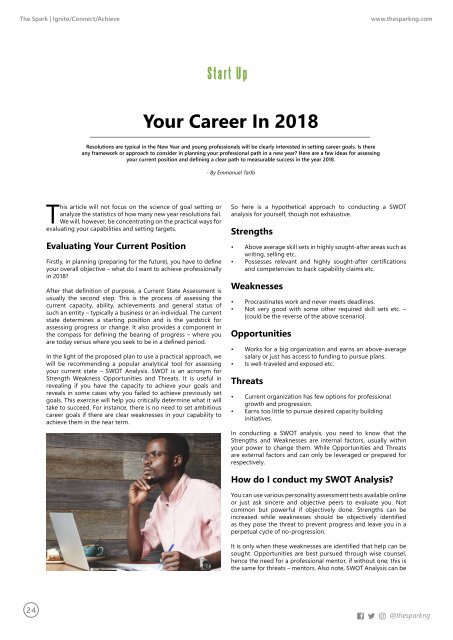January 2018
You also want an ePaper? Increase the reach of your titles
YUMPU automatically turns print PDFs into web optimized ePapers that Google loves.
The Spark | Ignite/Connect/Achieve<br />
www.thesparkng.com<br />
Start Up<br />
Your Career In <strong>2018</strong><br />
Resolutions are typical in the New Year and young professionals will be clearly interested in setting career goals. Is there<br />
any framework or approach to consider in planning your professional path in a new year? Here are a few ideas for assessing<br />
your current position and defining a clear path to measurable success in the year <strong>2018</strong>.<br />
- By Emmanuel Tarfa<br />
This article will not focus on the science of goal setting or<br />
analyze the statistics of how many new year resolutions fail.<br />
We will, however, be concentrating on the practical ways for<br />
evaluating your capabilities and setting targets.<br />
Evaluating Your Current Position<br />
Firstly, in planning (preparing for the future), you have to define<br />
your overall objective – what do I want to achieve professionally<br />
in <strong>2018</strong>?<br />
After that definition of purpose, a Current State Assessment is<br />
usually the second step. This is the process of assessing the<br />
current capacity, ability, achievements and general status of<br />
such an entity – typically a business or an individual. The current<br />
state determines a starting position and is the yardstick for<br />
assessing progress or change. It also provides a component in<br />
the compass for defining the bearing of progress – where you<br />
are today versus where you seek to be in a defined period.<br />
In the light of the proposed plan to use a practical approach, we<br />
will be recommending a popular analytical tool for assessing<br />
your current state – SWOT Analysis. SWOT is an acronym for<br />
Strength Weakness Opportunities and Threats. It is useful in<br />
revealing if you have the capacity to achieve your goals and<br />
reveals in some cases why you failed to achieve previously set<br />
goals. This exercise will help you critically determine what it will<br />
take to succeed. For instance, there is no need to set ambitious<br />
career goals if there are clear weaknesses in your capability to<br />
achieve them in the near term.<br />
So here is a hypothetical approach to conducting a SWOT<br />
analysis for yourself, though not exhaustive.<br />
Strengths<br />
• Above average skill sets in highly sought-after areas such as<br />
writing, selling etc.<br />
• Possesses relevant and highly sought-after certifications<br />
and competencies to back capability claims etc.<br />
Weaknesses<br />
• Procrastinates work and never meets deadlines.<br />
• Not very good with some other required skill sets etc. –<br />
[could be the reverse of the above scenario].<br />
Opportunities<br />
• Works for a big organization and earns an above-average<br />
salary or just has access to funding to pursue plans.<br />
• Is well-traveled and exposed etc.<br />
Threats<br />
• Current organization has few options for professional<br />
growth and progression.<br />
• Earns too little to pursue desired capacity building<br />
initiatives.<br />
In conducting a SWOT analysis, you need to know that the<br />
Strengths and Weaknesses are internal factors, usually within<br />
your power to change them. While Opportunities and Threats<br />
are external factors and can only be leveraged or prepared for<br />
respectively.<br />
How do I conduct my SWOT Analysis?<br />
You can use various personality assessment tests available online<br />
or just ask sincere and objective peers to evaluate you. Not<br />
common but powerful if objectively done. Strengths can be<br />
increased while weaknesses should be objectively identified<br />
as they pose the threat to prevent progress and leave you in a<br />
perpetual cycle of no-progression.<br />
It is only when these weaknesses are identified that help can be<br />
sought. Opportunities are best pursued through wise counsel,<br />
hence the need for a professional mentor, if without one; this is<br />
the same for threats – mentors. Also note, SWOT Analysis can be<br />
24<br />
@thesparkng








